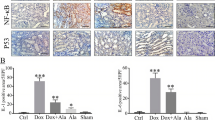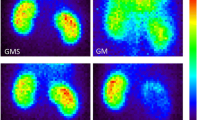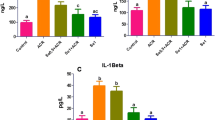Abstract
To evaluate the nephroprotective effect of edaravone on doxorubicin-induced nephrotoxicity. In this experimental study, twenty-eight Wistar male rats were used. The rats were separated into 4 groups (n = 7); group І (control), rats were treated with saline (4 ml/kg) and group ІІ (doxorubicin), nephrotoxicity was induced by three doses of 18 mg/kg/i.p. doxorubicin, at a 24-h interval on the 12th, 13th, and 14th days. Group ІІІ (edaravone), rats were treated with edaravone (30 mg/kg/for 14 days), and group ІV (edaravone + doxorubicin), rats were treated with edaravone (30 mg/kg/for 14 days) and doxorubicin were injected (18 mg/kg/for 3 days; at a 24-h interval on the 12th, 13th, and 14th days). On the 15th day of the experiment, technetium-99m-labeled dimercaptosuccinic acid ([99mTc]DMSA) uptake was obtained in both kidneys and biochemical parameters from serum and kidney tissue were measured. Doxorubicin led to nephrotoxicity through elevation of serum blood urea nitrogen (BUN), creatinine and tumor necrosis factor-α (TNF-α), nitric oxide (NO), and interleukin-6 (IL-6) in kidney tissue and decreased [99mTc]DMSA uptake level in the kidney when compared with control group (p < 0.01). Pretreatment edaravone significantly decreased BUN and creatinine, also kidney tissue TNF-α, IL-6, NO, and increased [99mTc]DMSA uptake level compared with the doxorubicin. Edaravone has a significant nephroprotective effect through the attenuation of oxidative stress and inflammatory markers during doxorubicin-induced nephrotoxicity in rats.





Similar content being viewed by others
References
Ali ZK, Baker DE (2017) Formulary drug review: edaravone. Hosp Pharm 52:732–736
Araujo M, Welch WJ (2006) Oxidative stress and nitric oxide in kidney function. Curr Opin Nephrol Hypertens 15(1):72–77
Aygun H, Gul SS (2019a) Protective effect of melatonin and agomelatine on adriamycin induced nephrotoxicity in rat model: a renal scintigraphy and biochemical study. Bratisl Lek Listy 120(2):113–118
Aygun H, Gul S (2019b) Protective effect of edaravone on adriamycin-induced cardiotoxicity in rats. Cumhuriyet Med J 41(1):10–18. https://doi.org/10.7197/223.vi.531824
Badary OA, Abdel-Naim AB, Abdel-Wahab MH, Hamada FMA (2000) The influence of thymoquinone on doxorubicin-induced hyperlipidemic nephropathy in rats. Toxicology 143:219–226
Bailly C (2019). Potential use of edaravone to reduce specific side effects of chemo-, radio- and immuno-therapy of cancers. Int Immunopharmacol. 77:105967. https://doi.org/10.1016/j.intimp.2019.105967
Baroni EA, Costa RS, Volpini R, Coimbra TM (1999) Sodium bicarbonate treatment reduces renal injury, renal production of transforming growth factor-b, and urinary transforming growth factor-b excretion in rats with doxorubicin-induced nephropathy. Am J Kidney Dis 34(2):328–337
Basol N, Aygun H, Gul SS (2019) Beneficial effects of edaravone in experimental model of amitriptyline-induced cardiotoxicity in rats. Naunyn Schmiedeberg's Arch Pharmacol 392(11):1447–1453
Baud L, Ardaillou R (1995) Tumor necrosis factor in renal injury. Miner Electrolyte Metab 21:336–341
Cabuk M, Gurel A, Sen F, Demircan N (2008) Renoprotective effect of erdosteine in rats against gentamicin nephrotoxicity: a comparison of 99mTc-DMSA uptake with biochemical studies. Mol Cell Biochem 308(1–2):35–42
Dash RP, Babu RJ, Srinivas NR (2018) Two decades-long journey from riluzole to edaravone: revisiting the clinical pharmacokinetics of the only two amyotrophic lateral sclerosis therapeutics. Clin Pharmacokinet 57:1385–1398
Dijkstra G, Moshage H, Jansen PL (2002) Blockade of NF-kappaB activation and donation of nitric oxide: new treatment options in inflammatory bowel disease. Scandinavian J Gastroenterol Supp 37(236):37–41
Doi K, Suzuki Y, Nakao A, Fujita T, Noiri E (2004) Radical scavenger edaravone developed for clinical use ameliorates ischemia/reperfusion injury in rat kidney. Kidney Int 65:1714–1723
Edelstein CL (2008) Biomarkers of acute kidney injury. Adv Chronic Kidney Dis 15(3):222–234
Fujiwara N, Som AT, Pham LT et al (2016) A free radical scavenger edaravone suppresses systemic inflammatory responses in a rat transient focal ischemia model. Neurosci Lett 633:7–13
Gül SS, Aygün H (2019) Cardioprotective effect of vitamin D and melatonin on doxorubicin-induced cardiotoxicity in rat model: an electrocardiographic, scintigraphic and biochemical study. Eur Respir J 5(4):649–657
Hishida A (2007) Clinical analysis of 207 patients who developed renal disorders during or after treatment with edaravone reported during post-marketing surveillance. Clin Exp Nephrol 11(4):292–296
Hosseinimehr SJ, Asadian R, Naghshvar F et al (2015) Protective effects of thymol against nephrotoxicity induced by cisplatin with using 99mTc-DMSA in mice. Ren Fail 37(2):280–284
Jo CH, Kim S, Park JS, Kim GH (2018) Anti-inflammatory action of sitagliptin and linagliptin in doxorubicin nephropathy. Kidney Blood Press Res 43(3):987–999
Kang J, Lee Y, No K, Jung E, Sung J, Kim Y, Nam S (2002) Ginseng intestinal metabolite-I (GIM-I) reduces doxorubicin toxicity in the mouse testis. Reprod Toxicol 16:291–298
Khaloozadeh H, Yazdanbakhsh P, Homaei-shandiz F (2008) The optimal dose of CAF regimen in adjuvant chemotherapy for breast cancer patients at stage IIB. Math Biosci 213:151e158
Kikuchi K, Takeshige N, Miura N et al (2012) Beyond free radical scavenging: beneficial effects of edaravone (Radicut) in various diseases (review). Exp Ther Med 3(1):3–8
Korga A, Dudka J, Burdan F, Sliwinska J, Mandziuk S, Dawidek-Pietryka K (2012). The redox imbalance and the reduction of contractile protein content in rat hearts administered with L thyroxine and Doxorubicin. Oxid Med Cell Longev 681367. https://doi.org/10.1155/2012/681367
Labato M, Ross L (1991) Plasma disappearance of creatinine as a renal function test in the dog. Res Vet Sci 50(3):253–258
Lee VW, Harris DC (2011) Adriamycin nephropathy: a model of focal segmental glomerulosclerosis. Nephrol 16(1):30–33
Liu Z, Yang C, Meng X, Li Z, Lv C, Cao P (2018) Neuroprotection of edaravone on the hippocampus of kainate-induced epilepsy rats through Nrf2/HO-1 pathway. Neurochem Int 112:159–165
Mejia J, Miranda ACC, Durante ACR, Oliveira LR, Barboza MR, Rosell KT, Jardim DP, Campos AH, Reis MA, Catanoso MF, Galvis-Alonso OY, Cabral FR (2016) Preclinical molecular imaging: development of instrumentation for translational research with small laboratory animals. Einstein (Sao Paulo) 14(3):408–414
Montilla P, Tunez I, Munoz MC, Lopez A, Soria JV (1997) Hyperlipidemic nephropathy induced by adriamycin: effect of melatonin administration. Nephron 76(3):345–350
Park J, Kanayama A, Yamamoto K, Miyamoto Y (2012) ARD1 binding to RIP1 mediates doxorubicin-induced NF-kappaB activation. Biochem Biophys Res Commun 422:291–297
Patil RR, Guhagarkar SA, Devarajan PV (2008) Engineered nanocarriers of doxorubicin: a current update. Crit Rev Ther Drug Carrier Syst 25:1–61
Poljakovic M, Nygren JM, Persson K (2003) Signalling pathways regulating inducible nitric oxide synthase expression in human kidney epithelial cells. Eur J Pharmacol 23:21–28
Saad SY, Najjar TA, AL-Rirkabi AC (2001) The preventive role of deferoamine against acute doxorubicin-induced cardiac, renal and hepatic toxicity in rats. Pharmacol Res 43:211e218
Sattarinezhad E, Panjehshahin MR, Torabinezhad S et al (2017) Protective effect of edaravone against cyclosporine-induced chronic nephropathy through antioxidant and nitric oxide modulating pathways in rats. Iran J Med Sci 42(2):170–178
Shafik A, Khodeir MM, Fadel MS (2011) Animal study of anthracycline-induced cardiotoxicity and nephrotoxicity and evaluation of protective agents. J Cancer Sci Ther 3:96e103
Stark G (2005) Functional consequences of oxidative membrane damage. J Membr Biol 205:1–16
Sueishi K, Mishima K, Makino K, Itoh Y, Tsuruya K, Hirakata H, Oishi R (2002) Protection by a radical scavenger edaravone against cisplatin-induced nephrotoxicity in rats. Eur J Pharmacol 451:203–208
Takei K, Watanabe K, Yuki S, Akimoto M, Sakata T, Palumbo J (2017) Edaravone and its clinical development for amyotrophic lateral sclerosis. Amyotroph Lateral Scler Frontotemporal Degener 18(sup1):5–10
Tangpong J, Cole MP, Sultana R, Joshi G, Estus S, Vore M, St Clair W, Ratanachaiyavong S, St Clair DK, Butterfield DA (2006) Adriamycin-induced, TNF-α-mediated central nervous system toxicity. Neurobiol Dis 23(1):127–139
Tien CC, Peng YC, Yang FL, Subeq YM, Lee RP (2016) Slow infusion rate of doxorubicin induces higher pro-inflammatory cytokine production. Regul Toxicol Pharmacol 81:69–76
Ujhazy P, Zaleskis G, Mihich E, Ehrke MJ, Berleth ES (2003) Doxorubicin induces specific immune functions and cytokine expression in peritoneal cells. Cancer Immunol Immunother 52(7):463–472
Usta Y, Ismailoglu UB, Bakkaloglu A et al (2004) Effects of pentoxifylline in adriamycin-induced renal disease in rats. Pediatr Nephrol 19(8):840–843
Varatharajan R, Jun LH, Kai TZ, Jian LW, Anburaj J, Vijayan V (2017) Morphological and morphometric study of edaravone in gentamicin-induced nephrotoxicity in Sprague Dawley rats. J Young Pharm 9(1):31–35
Wei MG, He W M, Lu X, et al. (2016). JiaWeiDangGui decoction ameliorates proteinuria and kidney injury in Adriamycin-induced rat by blockade of TGF-β/Smad signaling. Evid Based Complement Alternat Med, 5031890. https://doi.org/10.1155/2016/5031890
Yang W, Wang J, Shi L, Yu L, Qian Y, Liu Y, Wang W, Cheng S (2012) Podocyte injury and overexpression of vascular endothelial growth factor and transforming growth factor-beta 1 in adriamycin-induced nephropathy in rats. Cytokine 59(2):370–376
Yi R, Zhizhou Y, Zhaorui S, Wei S, Xin C, Shinan N (2019) Retrospective study of clinical features and prognosis of edaravone in the treatment of paraquat poisoning. Medicine (Baltimore) 98:e15441
Yurekli Y, Unak P, Yenisey C, Ertay T, Biber Muftuler FZ, Medine EI (2011) L-carnitine protection against cisplatin nephrotoxicity in rats: comparison with amifostin using quantitative renal Tc 99m DMSA uptake. Mol Imaging Radionucl Ther 20(1):1–6
Zhang YW, Shi J, Li YJ, Wei L (2009) Cardiomyocyte death in doxorubicin-induced cardiotoxicity. Arch Immunol Ther Exp 57:435–445
Zhang S, Chen ZX, Jiang YY, Cai QQ, Yang ZH, Wang CR, Wu XY, Ying P, Lu ZQ (2017) Intervention of edaravone against renal injury induced by acute paraquat poisoning in rats. Zhonghua Lao Dong Wei Sheng Zhi Ye Bing Za Zhi 35(6):408–413
Author information
Authors and Affiliations
Contributions
HA: research concept and design. HA, FD, MD: conducting experiments, data collecting, analysis, and interpretation of data. HA: Preparation of articles and revisions. All authors read and approved the final version of the manuscript.
Corresponding author
Ethics declarations
Conflict of interest
The authors declare that they have no conflict of interest.
Additional information
Publisher’s note
Springer Nature remains neutral with regard to jurisdictional claims in published maps and institutional affiliations.
Rights and permissions
About this article
Cite this article
Demir, F., Demir, M. & Aygun, H. Evaluation of the protective effect of edaravone on doxorubicin nephrotoxicity by [99mTc]DMSA renal scintigraphy and biochemical methods. Naunyn-Schmiedeberg's Arch Pharmacol 393, 1383–1390 (2020). https://doi.org/10.1007/s00210-020-01832-2
Received:
Accepted:
Published:
Issue Date:
DOI: https://doi.org/10.1007/s00210-020-01832-2




